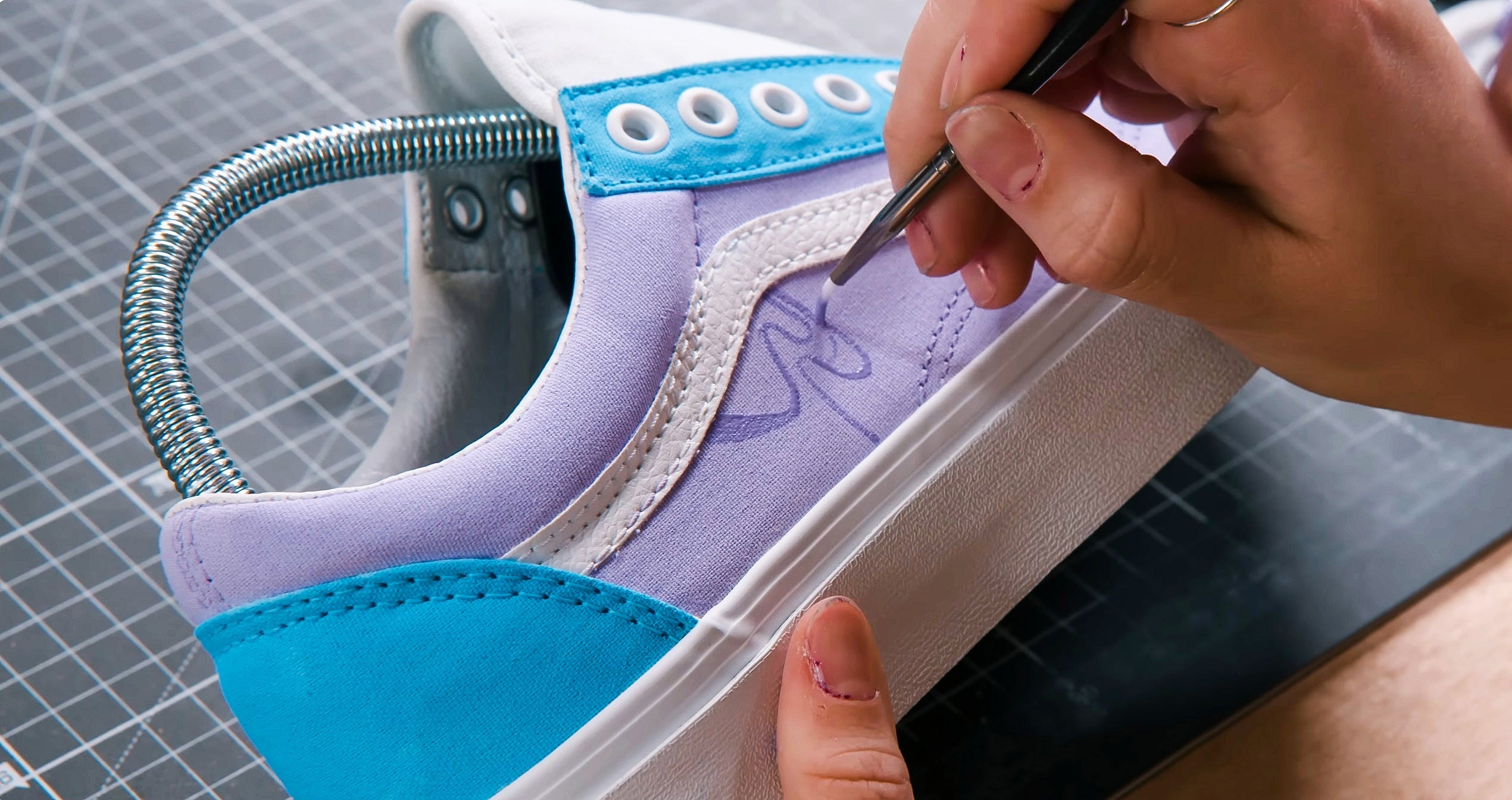Canvas shoes, with their blank slate appeal, offer an irresistible canvas for creativity. Transforming a simple pair into a unique piece of wearable art is a rewarding endeavor that combines artistic expression with personal style. While the idea might seem daunting, with the right guidance and materials, anyone can embark on this exciting journey of how to paint canvas shoes.
This guide will walk you through the process of how to paint canvas shoes, from choosing the perfect pair to applying the finishing touches. We'll explore essential supplies, design techniques, and care tips to help you create stunning custom footwear and learn how to paint tennis shoes.
Choosing Your Canvas Shoes

The foundation of any great artwork is the canvas itself. In this case, your canvas is a pair of shoes. Opting for a high-quality canvas shoe will ensure that your masterpiece lasts. Look for shoes with a sturdy sole and a smooth, even canvas upper. A variety of options are available, from classic slip-ons to high-top sneakers.
Essential Supplies
Before diving into the creative process, gather the necessary tools. A well-stocked arsenal will streamline your workflow and enhance your results.
Acrylic paints: A versatile choice for shoe painting, acrylics offer a wide range of colors and dry quickly. High-quality acrylic paints provide excellent coverage and durability.
Brushes: Brushes: Invest in a variety of brush sizes to accommodate different design elements. Flat brushes are great for covering large areas, while round brushes are ideal for details. Look for brushes specifically designed for precision and versatility, such as those available in comprehensive sets.
Pencil or marker: For outlining your design. Choose tools that provide clean, clear lines to make your design process smoother.
Painter's tape: To protect areas you don't want to paint. Using painter's tape that adheres well and removes cleanly ensures sharp, professional edges.
Primer: Essential for ensuring paint adhesion. Select a primer compatible with your paint choice and the material of your shoes for the best results.
Finisher: To seal and protect your artwork. A good finisher preserves the vibrancy of your colors and provides a durable, protective coating.
Equipping yourself with these essential supplies, ensures you’re ready to create stunning custom designs with ease.
Preparing Your Workspace for Painting Canvas Shoes
A well-organized workspace is crucial for a successful painting project. Choose a clean, well-lit area where you can spread out your materials comfortably. Protect your work surface with newspaper or a drop cloth.

Prepping the Shoes Before You Painting Canvas Sneakers
Before unleashing your artistic flair, prepare your shoes for the transformation.
Cleaning
- Before painting, remove dirt and debris from the shoes using a soft brush or cloth. Pay attention to the soles and laces, as these areas can accumulate dirt. Using a comprehensive cleaning kit can make this process more efficient and effective. Need help? Check out our guide on how to clean your sneakers for detailed steps
Drying
- Ensure the shoes are completely dry before proceeding to the next step. Any moisture can interfere with the paint adhesion.
Priming
- Apply a coat of primer specifically designed for fabric to the canvas areas of the shoes.
- Allow the primer to dry completely according to the product instructions.
- Priming creates a smooth surface for the paint to adhere to, preventing peeling and cracking.
Designing Your Masterpiece
The heart of any great shoe design lies in careful planning.
Inspiration
- Draw inspiration from your surroundings, personal interests, or existing artwork.
- Consider the style and color palette that complements your wardrobe.
- Create a mood board or collect images for reference.
Sketching
- Sketch your design on paper to visualize the final look.
- Experiment with different layouts and color combinations.
- Refine your design until you're satisfied.
Transferring the Design
- Lightly sketch the outline of your design onto the shoes using a pencil or marker.
- Be gentle to avoid damaging the fabric.
- For intricate designs, consider using tracing paper or a projector to assist with the transfer process.
Painting Process

With your design outlined, it's time to bring your vision to life.
Base Coats
- Apply base colors to large areas of the shoe.
- Use flat brushes for even coverage.
- Allow each coat to dry completely before applying the next.
Building Layers
- Gradually build up layers of paint to achieve the desired opacity and color intensity.
- Thinner layers are generally preferable to avoid cracking.
- Experiment with different painting techniques, such as dry brushing, sponging, or stippling, to create texture and dimension when you paint canvas sneakers.
Detail Work
- Use smaller brushes to add intricate details, outlines, and highlights.
- Take your time and focus on precision.
- Consider using a steady hand or a stencil for complex patterns.
Finishing Touches

Once the main design is complete, add the finishing touches to elevate your artwork.
Accents and Embellishments
- Incorporate additional elements like glitter, sequins, studs, or fabric appliqués to enhance the design.
- Use these accents sparingly to avoid overwhelming the overall look.
Outlines
- Define the edges of your design with a contrasting color or black outline.
- This step adds clarity and professionalism to your artwork.
Sealing and Protecting Your Creation
To ensure the longevity of your painted shoes, it's essential to seal and protect them.
Applying Finisher
- Choose a high-quality fabric sealer or finisher specifically designed for footwear.
- Apply an even coat of sealer to the entire shoe, including the sole.
- Allow the sealer to dry completely according to the product instructions.
Curing Time
- Give the sealer ample time to cure before wearing the shoes.
- This ensures the paint and sealer are fully bonded, preventing damage.
Care and Maintenance
To keep your painted shoes looking their best, follow these shoe care tips:
- Avoid submerging your shoes in water.
- Spot clean any stains with a mild detergent and damp cloth.
- Allow your shoes to air dry completely after cleaning.
- Store your shoes in a cool, dry place away from direct sunlight.
Troubleshooting and Tips
Even the most seasoned artists encounter challenges. Here are some common issues and solutions:
Paint Issues
- Paint Peeling: Inadequate preparation is often the culprit. Ensure the shoes are clean, dry, and primed before painting.
- Color Fading: Using a quality finisher can help prevent color fading. Additionally, avoiding direct sunlight can prolong the life of your artwork.
- Uneven Coverage: Multiple thin coats are generally better than one thick coat. Allow each coat to dry completely before applying the next when you paint canvas shoes.
Design Challenges
- Lack of Inspiration: Explore various sources of inspiration, such as nature, fashion, art, and personal interests.
- Difficulty Transferring Design: Practice your sketching skills or use tracing paper or a projector for more complex designs when learning how to paint a canvas shoe.
- Design Overwhelm: Start with a simple design and gradually add complexity as you gain confidence.
General Tips
- Patience is Key: Allow ample drying time between coats of paint and sealer.
- Experimentation: Don't be afraid to try new techniques and styles.
- Practice Makes Perfect: The more you paint, the better you'll become.
- Protect Your Workspace: Cover your work area with newspaper or a drop cloth to prevent paint spills.
- Clean Up: Clean your brushes thoroughly after each use to prolong their life.
Inspiring Your Creativity

(Source: @truebluecustoms)
Once you've mastered the basics of how to paint shoes canvas, it's time to explore endless creative possibilities. Here are some ideas to spark your imagination for your painted canvas shoes:
- Collaborate with Others: Partner with friends or family for a joint project.
- Create a Series: Develop a theme or character and create multiple designs based on it.
- Experiment with Different Styles: Try abstract, geometric, or pop art styles.
- Incorporate Personal Touches: Add your initials, a favorite quote, or a special date.
- Share Your Creations: Showcase your artwork on social media or participate in local art contests.
Ready to transform your canvas shoes into unique works of art? This comprehensive guide provides everything you need to unleash your creativity, from choosing the perfect paints to sealing your masterpiece. For long-lasting, vibrant colors, consider exploring high-quality acrylic paints designed specifically for footwear. With a little planning and the right materials, you can create stunning custom shoes that reflect your own personal style. Visit our resource section to delve deeper into the world of shoe painting and discover everything you need to get started and understand what kind of paint to use on shoes.
FAQ
What type of paint should I use on canvas shoes?
Use high-quality acrylic paints designed for fabric or footwear. They offer excellent coverage, durability, and flexibility, ensuring your design stays vibrant and crack-free.
Can I mix different brands of acrylic paint when painting canvas shoes?
While it's possible to mix different brands, for the best results, stick to high-quality, specialized acrylic paints designed for fabric or footwear. Angelus Direct is one of the trusted brands that offers top-notch acrylic paints, ensuring your designs are vibrant and durable.
Do I need to apply a primer before painting canvas shoes?
Yes, applying a primer designed for fabric helps the paint adhere better and prevents peeling. It creates a smooth base for your artwork.
How can I protect my painted canvas shoes from water and stains?
After painting your canvas shoes, it's essential to protect them from water and stains to maintain their appearance. Applying a water and stain repellent, like Angelus Water & Stain Repellent, will create a protective barrier that helps preserve your artwork and keeps your shoes looking fresh.
How do I protect my painted canvas shoes?
After painting, apply a fabric sealer or finisher to protect your design. This will help maintain the vibrancy of the colors and shield the shoes from wear and tear.
Can I wash my painted canvas shoes?
Avoid submerging them in water. Instead, spot clean with a mild detergent and damp cloth. This helps preserve both the paint and the integrity of the shoe.
What should I do if the paint starts to peel?
If paint starts peeling, it may be due to inadequate preparation. Make sure the shoes are clean, dry, and primed before repainting any areas that need touch-ups.

